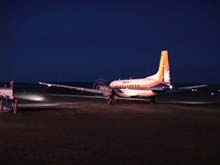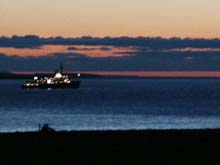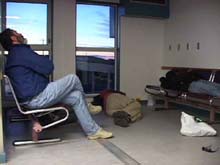
Disembarking from the charter flight to Coppermine marked the true beginning of the Arctic Exploration. Within a few minutes, the plane departed for the return trip to Yellowknife, leaving the Arctic team awaiting the ship’s helicopter at first light. Click image for larger view.
Exploration Methods Come Together at Explorer Ridge
August 14, 2002
 Journey to the Louis St. Laurent via helicopter as the scientists are transferred to the ship. (mp4, 3.3 MB).
Journey to the Louis St. Laurent via helicopter as the scientists are transferred to the ship. (mp4, 3.3 MB).
Jeremy Potter
NOAA Office of Ocean Exploration
With work in the Arctic comes a tangle of frustrating logistical challenges. (Some would argue that "nightmares" might be a more appropriate word.) Simply getting to the ship often proves exasperating for even the most patient person. The 2002 Arctic Exploration officially began from Coppermine (Kugluktuk), Canada at around 4:30 am on August 14th. For most of the explorers, however, the journey began well before then.
Canadian scientists chartered a flight from Yellowknife, AK, to Coppermine for the majority of the 46-person science team. Everyone needed to assemble in Yellowknife by 10:30 pm local time to catch the flight.
With people coming from Victoria, Corpus Christi, Seattle, the U.K., even Beijing and Tokyo, I presumed that the explorers flying in from Fairbanks, Alaska, would have an easier trip than most. After all, Fairbanks is a "mere" 826 mi northwest of Yellowknife (compared to the thousands of miles covered by other travelers). Upon arrival in Yellowknife, I quickly learned that in the Arctic, common sense is sometimes turned upside down.

Just offshore of Kugluktuk, dawn greets the CCGS Louis St. Laurent and the beginning of the 2002 Arctic Exploration. Click image for larger view.
Exploration Methods Come Together at Explorer Ridge
First, I had expected the rest of the science party to be overflowing with excitement and anticipation about the upcoming trip. Instead, after grabbing my luggage and walking to the opposite side of the airport (all of about 50 m), what I found were 28 others just like me -- bleary-eyed and exhausted from weeks of preparation and far too many hours on multiple airplanes.
And, to my surprise, the Fairbanks contingent seemed to have had the most difficult time. Unfortunately for them, there are no direct flights from Fairbanks to Yellowknife. No flights are even close to being direct. The 826-mi "hop, skip and jump" turned into an almost 3,000-mi circuitous slog, with tortuous layovers from Fairbanks south to Seattle, north to Edmonton, and finally on to Yellowknife. It actually took the Fairbanks team 7 hrs longer to get there than it took the group from Washington, DC, on the other side of the continent!
The question that had been nagging many of us for weeks was soon to be answered: Were we too heavy? To conserve precious research funds, the charter flight was smaller than ideal. About 2 wks before the flights, mission coordinators queried members of the science party on individual body weights. They calculated the total weight, divided it into the plane’s capacity, and allocated each person a maximum of approximately 90 lbs for luggage. Given that many of us were bringing scientific equipment, and that we were packing for a month in the Arctic, 90 lbs was not very much. Many of us went over the limit, hoping that others would not use their full quota. Unfortunately, if we were overweight, we would not find out until we were all together in Yellowknife. At that point, there would be few options for sending excess baggage the thousands of miles back home.
Luckily, it turned out that we were only slightly overweight. The flight crew was actually more concerned about the huge volume of baggage than its weight. After some creative stowing aboard the plane and burning off some excess fuel, we were ready to go. Considering that everyone and their gear made it on board, our departure alone was a huge accomplishment.
During the flight, a spectacular sunrise/sunset welcomed us to the chilly North. Since the sun never seems to dip below the horizon, the quandary over whether to call it a sunset or sunrise challenged my Mid-Atlantic sensibilities. The fight raged on in my mind until I decided just to sit back, enjoy the view, and accept that things are slightly different in the northern latitudes.
We arrived in Coppermine around 1:30 am on Aug. 14. The ship lay within sight just a few miles offshore. But with no way to get to her until helicopter operations started with dawn’s true arrival (around 4:30 am), individual members of the science team found various ways to pass the long 3 hrs. Wary of grizzly bears, some team members meandered around outside, ogling at the ship silhouetted against the orange glow in the distance. Many curled up on the floor or on the cold metal benches to catch a few hours of precious sleep. Others huddled inside the one-building airport, discussing where they came from and sharing expectations about the next month. A few even turned on their computers, sleepily typing in their first log entry for the cruise.
The hum of rotors at precisely 4:30 am roused everyone from their torpor. Within 5 min, the ship’s helicopter landed a scant 50 m from the building and the first 3 passengers climbed aboard. Every member of the science party was amazed by the speed and efficiency of the helicopter operations. In less than 10 min the helicopter had departed, landed on the ship, offloaded passengers, and returned to the airport, ready to transport the next 3 people.
It took a few hours to get the entire team and the gear out to the Canadian Coast Guard Ship (CCGS) Louis St. Laurent. The ship's crew and members of the Canadian science team warmly greeted our arrival. They had departed Halifax, Nova Scotia, on Aug. 2. The ship’s 46-person crew, along with the 4-person remotely operated vehicle (ROV) crew from Deep Sea Systems International Inc., spent the 13-day transit to Coppermine preparing the equipment for the month-long expedition
To a novice ocean explorer like myself, it seemed as if everything was finally coming together. The ship was ready, the entire science team had arrived, and all of the equipment was on board. After a few hours of sleep, I quickly learned that the "expedition" to get to the ship had simply been a warm-up. The real work and the logistical tangles were just beginning.
Sign up for the Ocean Explorer E-mail Update List.




























